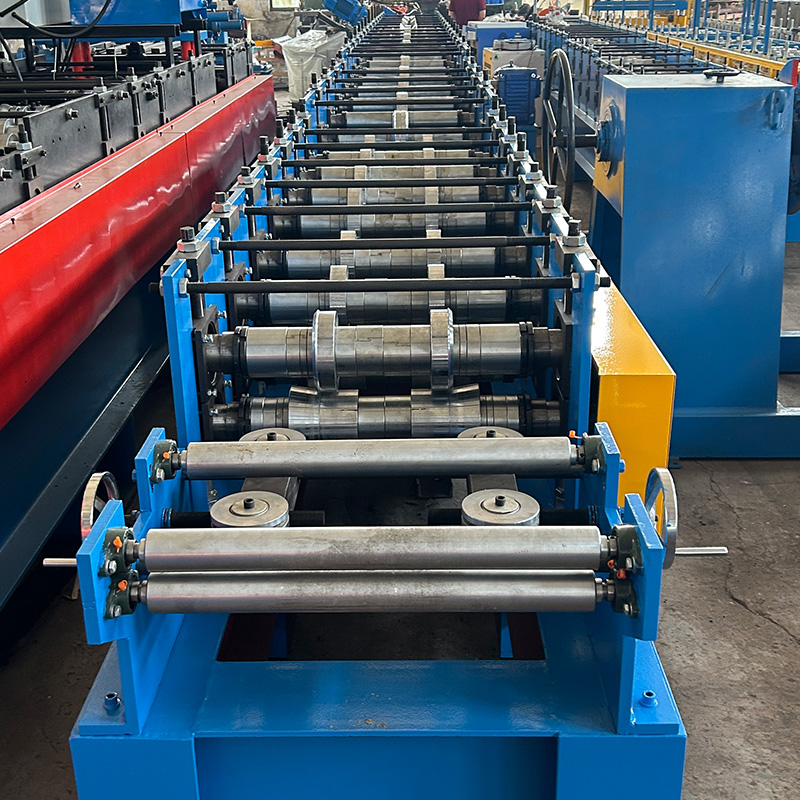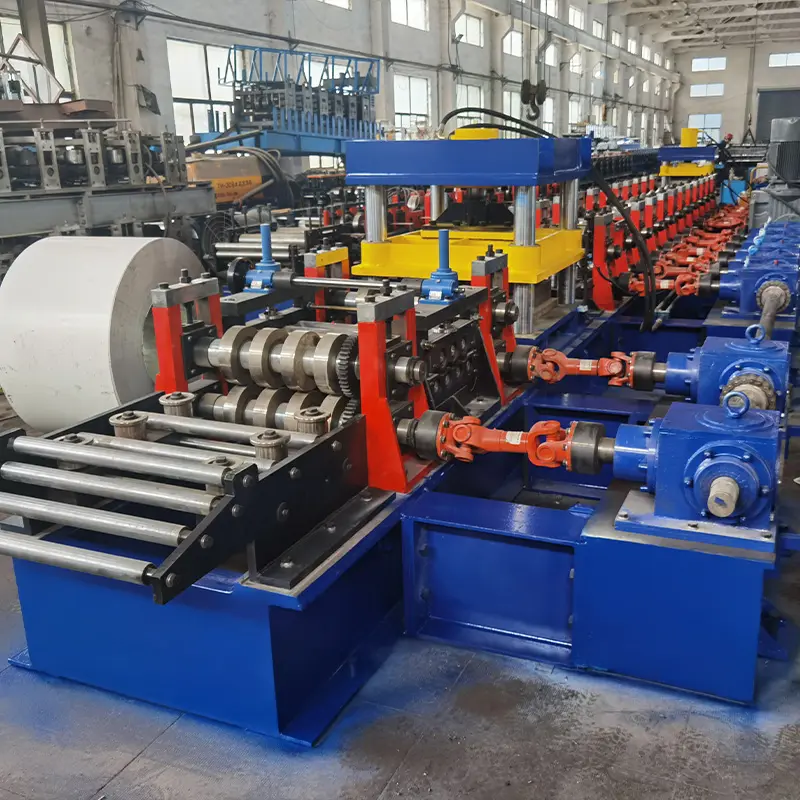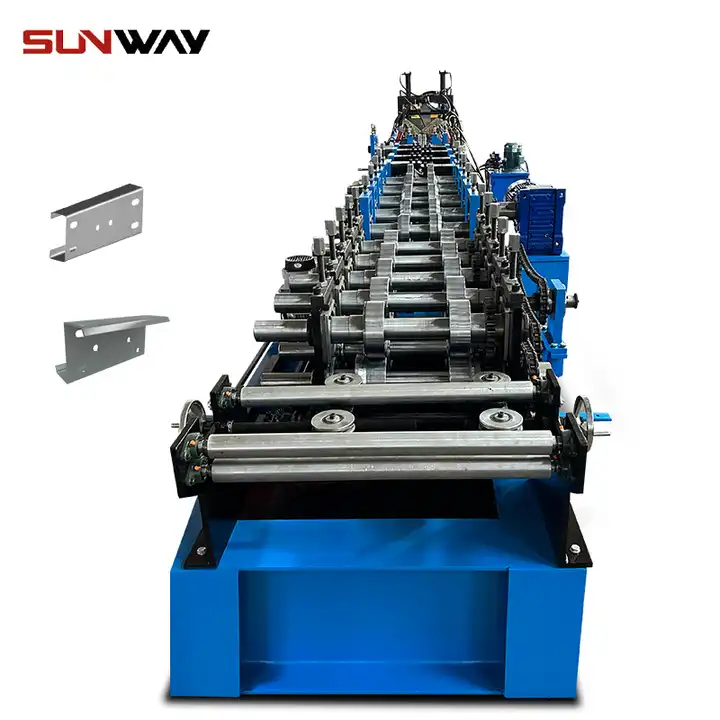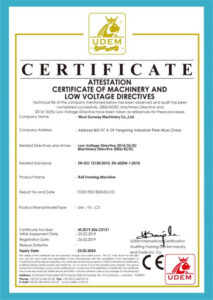Рулонная штамповка - это процесс изготовления металла, при котором листовой или рулонный металл непрерывно изгибается и формуется с помощью ряда роликов до получения нужного профиля поперечного сечения. Рамочные вальцовочные станки используются для создания рамных и конструкционных элементов со сложными профилями большой длины путем постепенной прокатки, резки и сварки из металлических рулонов.
По сравнению с другими технологическими процессами рулонная штамповка рам обеспечивает эффективный, экономичный и гибкий способ изготовления металлических каркасов с индивидуальными размерами и геометрией. В данном руководстве представлен подробный обзор различных аспектов технологии и оборудования для роликовой формовки рам.
Обзор машин для формовки рам
Рулонные машины постепенно формируют металлический лист или рулон в различные продольные однородные поперечные сечения и длинные отрезки с помощью серии проходов через последовательно расположенные валковые станции.
Ключевые атрибуты:
- Высокотехнологичное непрерывное производство длинномерных металлических каркасов из рулонов
- Возможность формирования сложных структурных форм с жесткими допусками
- Более низкие затраты на оснастку по сравнению с другими процессами, такими как штамповка или пресс-торможение
- Минимальные отходы материалов
- Постоянное качество и механические свойства по всей длине
- Высокая производительность для массового производства
Рамная прокатка включает в себя специализированные валковые машины, которые могут производить длинные структурные секции из металлических полос. Рамочные прокатные станы имеют очень прочную конструкцию с такими функциями, как серворегулирование валков, автоматическая подача материала, поточная сварка и резка, специально для высокопрочных каркасных изделий.
Типы машин для формовки рам
Существует два основных типа рамных валковых станов:
Одиночная линия рамы рулонные формовочные машины
- Предназначен для крупносерийного производства одного профиля
- Ограниченная гибкость - для изменения профиля необходимо менять вал.
- Примеры структурных секций: C, U, Z, верхняя крышка, дверная коробка
Универсальные валковые мельницы с быстросменной рамой
- Быстрая смена профилей с помощью систем быстросменных кассет
- Используется для низких и средних объемов производства с вариациями профилей
- Сократите время простоя при замене валов с нескольких часов до нескольких минут
- Идеально подходит для производителей дверей/оконных рам, стальной мебели и т.д.
Основные компоненты линий для формовки рам
Рамная система валковой формовки состоит из различных модульных компонентов для обработки материала, формовки и последующих процессов:
- Разматыватель или разматыватель - подает рулоны с сырьем в технологический процесс
- Сервоприводная система подачи валов - обеспечивает точное позиционирование материала
- Стенды для прокатки - постепенное формирование материала через серию валков
- Перфоратор - вырезы или пазы для крепления
- Стрижка и отсечение - нарезка профилей необходимой длины
- Сварочный аппарат - соединяет разрезанные секции для создания длинных непрерывных рам
- Гибочный станок с ЧПУ - при необходимости формирует специальные торцевые формы
- Таблицы биений - накапливать и расправлять готовую продукцию
- Автоматический штабелер - аккуратно складывает готовые изделия

Технические характеристики машины для формовки рам
Технические характеристики линии прокатки рам варьируются в зависимости от типа производимых профилей и требуемой производительности. К основным параметрам относятся:
| Параметр | Типовые технические характеристики |
|---|---|
| Сырье | Металлические рулонные полосы: Сталь, алюминий и т.д. |
| Толщина полосы | 0,3 - 3 мм |
| Ширина полосы | До 2,5 м |
| Длина готовых секций | 6 - 15 м или на заказ |
| Размеры секции | 20 - 300 мм обычно |
| Уровень производства | 10 - 35 м/мин |
| Годовой объем производства | 500 тонн - 10 000 тонн |
Требования к сырью
- Холоднокатаная сталь и рулоны оцинкованной стали обычно используются
- Алюминиевые катушки для легкого каркаса
- Нержавеющая сталь, медь для специальных нужд
- Внутренний диаметр рулона: стандартный 508 мм или 610 мм
Технические характеристики валковой оснастки
- Материалы роликов: Инструментальная сталь D2, S7 или CPM10V для долговечности
- Диаметры рулонов: 100 - 250 мм обычно
- Длина торца вала: До 1300 мм
- Кассеты быстрой смены: Обеспечивают быструю смену профилей
Варианты расположения линий
- Горизонтальный - материал перемещается горизонтально от разгрузчика до готовых штабелей
- Вертикальный - материал подается вертикально снизу вверх
- Компактная компоновка - минимизация занимаемой площади
- Индивидуальная планировка - с учетом площади завода
Система контроля
- Автоматизирует производственную последовательность и контролирует линию
- Системы управления, такие как ПЛК, HMI, сервоприводы, датчики
- Особенности программного обеспечения: Хранение параметров, диагностика
Основные области применения рамно-роликовых формовочных машин
Технология роликовой формовки рам идеально подходит для изготовления индивидуальных металлических каркасов различного назначения:
| Категория | Типовые применения |
|---|---|
| Здание и строительство | Стеновые стойки, кровельные фермы, дверные косяки, прогоны, направляющие, шпильки, стропила, архитектурное обрамление фасадов |
| Автомобильная промышленность | Рамы шасси, рамы пикапов, прицепы |
| Мебель | Металлические каркасы офисной мебели, полки, стеллажи, хранилища |
| Приборы | Холодильник, стиральная машина, сушилка, внутренние рамы |
| Конвейеры | Опорные рамы конвейеров |
| Solar | Наземное крепление, обрамление солнечных модулей на крыше |
Этот гибкий процесс позволяет прокатным станам удовлетворять требования к низким, средним и высоким объемам производства металлических элементов каркаса.
Выбор поставщика оборудования для формовки рам
Выбор подходящего производителя вальцовочных станков имеет решающее значение для получения оборудования, отвечающего необходимым производственным требованиям и стандартам качества. Ниже приведены основные соображения при выборе поставщика линии для формовки рам:
| Параметр | На что обратить внимание |
|---|---|
| Экспертиза | Обширный опыт в области формовки рам, подтвержденный послужной список |
| Настройка | Возможность настройки машин в соответствии с потребностями продукции |
| Качество | Использование высококачественных компонентов, международная сертификация качества |
| Технология | Расширенные возможности - системы быстрой замены, точное сервоуправление и т.д. |
| Услуги | Поддержка при установке, обучение операторов, послепродажное обслуживание |
| Надежность | Технологическая надежность, минимальное время простоя |
| Репутация | Положительные отзывы пользователей, довольные долгосрочные клиенты |
| Ценообразование | Конкурентоспособная цена за набор функций и производственные мощности |
| Время выполнения | Возможность поставки оборудования в соответствии с установленным графиком |
Производители, специализирующиеся на рамных валковых станах и поставляющие специализированные линии с надежными конструкциями, как правило, лучше всего подходят покупателям по сравнению с поставщиками оборудования для общей прокатки.
Диапазон цен на рамные роликоформовочные машины
Цены на рулонное оборудование варьируются в широком диапазоне в зависимости от его размеров, производительности, уровня автоматизации и возможностей дополнительной вторичной обработки.
Здесь представлен обзор диапазонов цен на новые рамные валковые станы:
| Тип машины | Типичный диапазон цен |
|---|---|
| Ручные и полуавтоматические линии | $40,000 – $100,000 |
| Автоматизированные линии средней производительности | $150,000 – $500,000 |
| Высокоскоростные автоматические линии | $600,000 – $2,000,000 |
| Большая широкая линия для рам шасси | Выше $2,000,000 |
Ключевые факторы, влияющие на стоимость:
- Скорость линии и годовая производительность
- Уровень автоматизации
- Вторичная обработка - штамповка, резка, штабелирование, сварка
- Толщина материала и размеры рамы
- Дополнительные потребности в настройке
Подержанное или бывшее в употреблении оборудование для формовки рамных валков также можно приобрести по более низким ценам, чем новые машины 30-50%.
Покупатели должны оценивать не только стоимость машины, но и общую стоимость владения, включая расходы на обслуживание. Поставщики, предоставляющие запасные части на местах, могут снизить стоимость владения в течение всего срока службы.
Как выбрать правильную машину для формовки рам
Выбор оптимального валкового оборудования требует соответствия между производственными потребностями и возможностями машины:
| Фактор | Как это влияет на выбор |
|---|---|
| Продукция | Конструктивные формы, размеры, толщина |
| Годовой объем | Скорость производства, необходимая скорость линии |
| Потребности в переключении | Быстрая смена по сравнению с фиксированной оснасткой |
| Вторичная переработка | Резка, штамповка, сварка, штабелирование |
| Бюджет | Диктует уровень автоматизации, скорость |
| Свободные места | Расположение линий в соответствии с имеющейся площадью |
| Уровень квалификации персонала | Необходимый уровень простоты автоматизации |
| Планы роста | Масштабируемость для будущих больших объемов |
Тесно сотрудничайте с поставщиками, вошедшими в короткий список, чтобы окончательно подобрать подходящую спецификацию с учетом ваших производственных требований для обеспечения оптимальной производительности и стоимости оборудования.

Монтаж и эксплуатация рамных валковых мельниц
Правильный монтаж и эксплуатация являются жизненно важными для бесперебойной работы линий прокатки рам. Вот несколько лучших практик:
- Аккуратно транспортируйте и устанавливайте оборудование в соответствии с инструкцией по установке
- Выровняйте и прочно прикрепите стойки к ровному основанию
- Проверка и подключение электрических, пневматических и гидравлических систем
- Нагрузочные испытания и точная настройка всех параметров машины
- Тщательно обучите персонал процедурам эксплуатации
- Проведение испытаний материалов и оптимизация наборов валков для получения целевых профилей
- Разработка стандартных операционных процедур и контрольных списков
- Контролировать оборудование для выявления любых отклонений от нормы
- Соблюдайте рекомендованный график технического обслуживания
- Для обслуживания используйте квалифицированных техников
- Обеспечить строгое соблюдение механизмов и протоколов безопасности
При наличии обученных операторов и профилактическом обслуживании рамные валковые линии могут работать в полную силу с минимальным временем простоя.
Основные советы по техническому обслуживанию рамных валковых мельниц
Регулярное техническое обслуживание имеет решающее значение для бесперебойной работы валковых машин. Вот некоторые ключевые мероприятия по техническому обслуживанию:
| Задача технического обслуживания | Подробности | Частота |
|---|---|---|
| осмотр | Проверьте, нет ли отклонений в работе | Ежедневно |
| Очистка валов и направляющих | Удалите металлическую пыль, смажьте | Еженедельник |
| Замена валов | Замена поврежденных/изношенных валов | По мере необходимости |
| Калибровка датчиков | Выравнивание/калибровка датчиков | Каждые 6 месяцев |
| Смазка | Смазывайте подшипники, шестерни, цепи | Ежемесячно |
| Гидравлическая система | Проверьте масло, фильтры, насосы, клапаны | Периодически |
| Электрическая система | Осмотрите проводку, элементы управления, двигатели | Ежегодно |
| Тестовый запуск | Проверьте работу машины без нагрузки | Ежемесячно |
Проактивное обслуживание валкового оборудования в соответствии с рекомендациями производителя предотвращает незапланированные простои и максимально продлевает срок службы.
Преимущества и достоинства роликовой формовки рам
Прокатная штамповка металлических профилей имеет множество преимуществ по сравнению с другими методами производства:
Преимущества включают:
- Производство непрерывных рам по индивидуальному заказу
- Сокращение отходов материалов
- Снижение инвестиций в оснастку
- Высокая точность и повторяемость размеров
- Постоянное качество по всей длине профиля
- Высокая скорость производства и пропускная способность
- Минимальные затраты на отделочные работы
- Масштабируемость для работы с большими объемами
- Более низкая стоимость изготовления каждой детали
- Производство точно в срок
Металлические рамы, изготовленные методом роликовой формовки, легче, прочнее и более однородны по сравнению с другими технологиями производства. Станки для формовки рам позволяют оптимально использовать свойства материала.
Ограничения и соображения, связанные с валковой формовкой
Несмотря на многочисленные преимущества, рулонная формовка рам имеет ряд присущих ей ограничений:
Вот некоторые соображения:
- Высокие первоначальные инвестиции в оборудование
- Исправленная оснастка ограничивает изменение профиля
- Ограничения в дизайне - ограничения на формы, особенности
- Не идеально подходит для малосерийного производства или производства прототипов
- Ограниченные возможности формовки за пределами простых изгибов
- Возможно, потребуются дополнительные этапы изготовления
- Для длинных выходов необходимо специальное место для хранения
- Необходим квалифицированный персонал для эксплуатации оборудования
- Значительное время подготовки к переналадке производства
Ограничения можно смягчить, выбрав гибкие быстросменные валковые станы, но ограничения по конструкции остаются. Этот процесс может оказаться неоптимальным для некоторых сложных нестандартных форм, производимых в очень малых количествах.

Часто задаваемые вопросы
Здесь приведены ответы на некоторые распространенные вопросы о роликовой формовке рам:
| Вопрос | Ответ |
|---|---|
| Какие металлы можно подвергать прокатке? | Большинство конструкционных металлов, таких как сталь, нержавеющая сталь, алюминий, латунь, медь, могут быть подвергнуты валковой формовке. Не подходит для литья/формовки. |
| Какие продукты можно производить? | Металлические стойки, фермы для крыш, солнечные батареи, дверные коробки, мебельные каркасы, детали шасси и т.д. Многие длинные структурные компоненты. |
| Какова длина готовых изделий? | Секции длиной до 15 м могут быть непрерывно сформированы и разрезаны на отрезки необходимой длины в соответствии с условиями применения. |
| Какие допуски могут быть достигнуты? | Рулонная формовка позволяет достичь допуска на размеры ±0,5 мм на отрезках длиной 15 м. |
| В чем преимущество перед штамповкой? | Низкая стоимость инструмента, минимальные отходы материала, гибкость, повышенная прочность, отсутствие ограничений по форме. |
| Требуется ли вторичная обработка? | Может потребоваться перфорация, резка, добавление отверстий, но это минимально по сравнению с другими методами. |
| Насколько легко изменить профиль? | Системы быстрой смены кассет позволяют менять профиль за считанные минуты по сравнению с часами традиционного процесса замены рулонов. |
| Какой уровень мастерства необходим? | Для операторов валков требуется 1-2-недельное обучение. Для персонала, занимающегося наладкой, необходимы знания по управлению. |
| Какие аспекты безопасности важны? | Охрана оборудования, аварийные остановки, обученный персонал. Следуйте стандартным протоколам. |
Рулонная штамповка представляет собой очень эффективный метод обработки для непрерывного производства металлических каркасов по индивидуальным заказам. При должном учете требований к конструкции изделия она обеспечивает ключевые преимущества по сравнению с другими вариантами изготовления.
Вывод
Рамная роликовая штамповка обеспечивает эффективное массовое производство высококачественных металлических конструкционных профилей с быстрой и гибкой настройкой профиля. Соотнесение производственных задач и требований к профилю с возможностями оборудования является ключевым фактором успеха производства.
Благодаря точным спецификациям, надежным технологическим процессам и надежному оборудованию валковая формовка каркаса обеспечивает легкий вес и высокую прочность деталей при минимизации отходов материала. Автоматизированные универсальные валковые станы оптимизируют производительность и качество для производителей металлоконструкций. При надлежащем техническом обслуживании и эксплуатации линии роликовой формовки рам обеспечивают стабильно низкую стоимость производства, что позволяет получить конкурентное преимущество.


